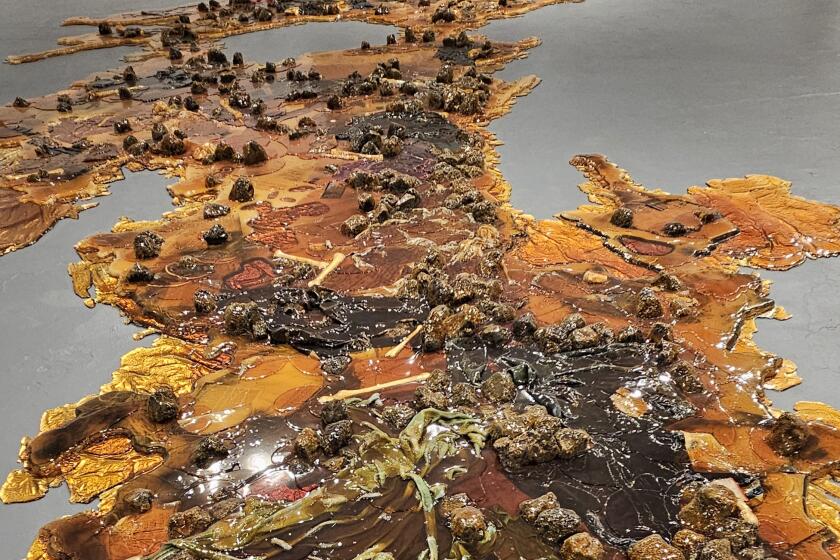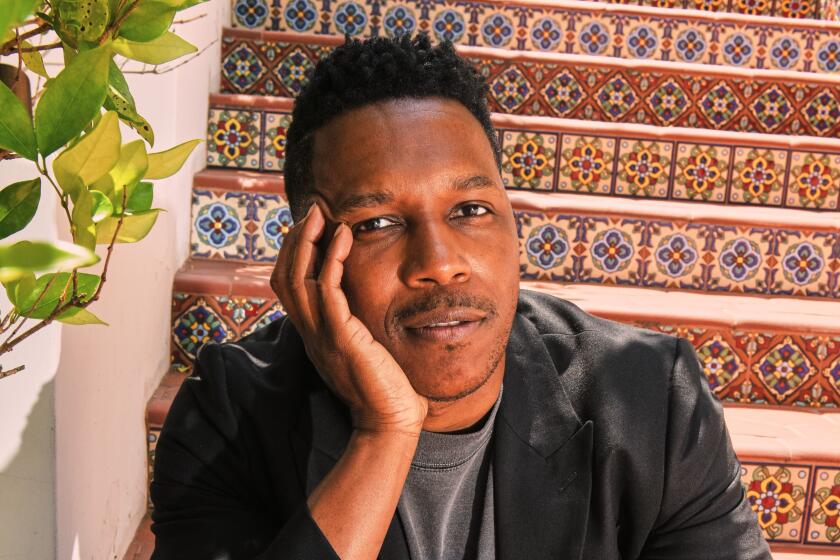Smart Sculptures With Fun-Loving Form
Inch-for-inch, Ken Price’s new works at L.A. Louver Gallery deliver more viewing pleasure than any other free-standing sculpture being made today. Compact and loaded, the eight gorgeous pieces in this extraordinary show fuse the side-splitting humor of animated cartoons with the hair-splitting refinement of Modern art’s most exquisite abstractions.
At once exuberant and intelligent, Price’s delightfully indescribable forms mix metaphors so fast and furiously that distinctions between highbrow sophistication and lowdown improvisation dissolve in whirlwinds of excitement. The only fear these fun-loving sculptures inspire is that you won’t be able to think quickly enough to keep up with the shifting associations they continually generate.
Take any one of the wide-ranging works here. “Underhung,” for example, resembles a sluggish sea creature that could be the impossible offspring of a menage a trois among a cow’s udder, an embryonic brontosaurus and the opening of an elephant’s trunk.
Salacious yet understated, this table-top sculpture evokes blind gropings beneath the sheets. It also infuses charged memories of adolescent exploration with a sense of dignity that is charming and sweet, while still edgy and breathless.
But just when you feel you’ve put your finger on exactly what makes a particular piece so irresistibly fascinating, the words you use to convey this sensation fall so far short of capturing its slippery thrills that you’ll need--and want--to start all over again. Thus “Underhung” begins to seem more like a cartoon gnome carrying on an animated conversation with itself; or a pair of almost completely fused Siamese twins; or a duo of giant, self-conscious cells that have mixed feelings about dividing and multiplying. Its pockmarked metallic finish also recalls low-riders and meteorites, or big melting ice cream cones and smooth lumps of solidified lava.
Such loopy references only scratch the surface of a single work. Three others resemble mutant fusions of the Michelin man and a sea anemone, or crosses between jellyfish and miniature dirigibles that have deflated and formed abstract landscapes.
The fusion between sculpture and landscape is a strange one. Sometimes, modern sculptures are located in manicured landscapes. Rarely do these works have the audacity to claim that they are landscapes themselves. But Price has never been very good at following rules, much less trends. His richly inventive art belongs to a category unto itself, one in which abstraction is hands-on, intimate and wildly open-ended. Deeply psychological, his sculptures compress, conflate and intensify in ways that would turn Freud green with envy.
* L.A. Louver Gallery, 45 N. Venice Blvd., (310) 822-4955, through Nov. 22. Closed Sundays and Mondays.
$$$$$$$$$$$: You can almost hear old-fashioned cash registers ringing up sales in the beautifully installed exhibition of Andy Warhol’s “Dollar Sign” paintings and drawings at Gagosian Gallery. Whether you buy one of the 69 works on display or not, the sound of commerce in action is music to one’s ears: Bold, crisp and unsentimental, it is a clarion call to decisive activity.
More than any other Modern artist, Warhol (1928-87) understood that commercial exchanges, like Modern paintings, leave no room for halfhearted speculators or looky-loos afraid to take risks. With all types of contemporary art, as with all types of commerce, every viewer must decide what he loves and what he doesn’t--and then live with the consequences.
Like all of Warhol’s best works, his “Dollar Sign” paintings initially look stupid. Each consists of two, three or four of these symbols, printed atop one another (yet slightly out of register), on various monochromatic backgrounds. Crass and seemingly unimaginative, these blunt works appear to merely illustrate the simple-minded idea that art is a commodity.
That’s what a generation of critics (some of whom are academic Marxists) have insisted. But their flat-footed application of economic theory misconstrues how art actually works in the world.
Warhol’s dollar signs make hay with this misunderstanding. With brutal directness, they assert that art functions less like a commodity and more like a currency.
Like money, pictures painted, drawn or silk-screened by artists have no intrinsic value. Whether an image is printed by the state or made by an individual, its value is determined by the social groups in which it has currency--be they collectors, critics and viewers, or other citizens, investors and business people.
The only reason some works are more valuable than others is because enough people agree that they’re desirable and put their money where their mouths are. In a sense, dollar bills are a very large (but not limitless) edition of prints that a very large number of people want. Think of Warhol’s “Dollar Sign” paintings as a much smaller version of the same thing, and you’ll get a sense of their incisive, surprisingly conceptual kick.
Made in 1981, when abstract painting was probably the most devalued art form around, Warhol’s “Dollar Sign” series put some punch back into that style. As self-referential as any high Modernist abstraction, they depict nothing but abstract value, just like Abstract Expressionism did, but in a more socially oriented manner.
Warhol’s canvases also invite viewers to make old-fashioned aesthetic decisions. Just try to decide which painting is your favorite, and you’ll see how these works deliver such painterly goods as color, line and gesture, while demanding, from viewers, all-or-nothing responses.
* Gagosian Gallery, 456 N. Camden Drive, Beverly Hills, (310) 271- 9400, through Nov. 29. Closed Sundays and Mondays.
Automatic Art: A rich slice of art history awaits visitors to the first gallery exhibition of Robert Motherwell’s works since the renowned painter’s death in 1991 at the age of 76. At Manny Silverman Gallery, 37 small- to medium-size inks, acrylics and oils on paper and board (dating from 1950-91) look so fresh and light-handed that they’ll make you think Abstract Expressionism was neither abstract nor expressionistic.
Very few of Motherwell’s masterful splatters, puddles and spills of swiftly brushed color add up to anything that resembles an abstract image. Although a handful of his works distills views of landscapes, birds, figures and war machines down to their basic formats--by abstracting their essential components to form simplified compositions--most of his works do not refer to the exterior world in any way, shape or form.
Neither do they express the artist’s inner sentiments, buried emotions or inarticulate feelings. Drawn swiftly and with as little conscious planning as possible, Motherwell’s “automatic drawings” rank, to their credit, among this technique’s coolest, most impersonal works.
If you’re looking for signs of the artist’s unconscious among the jittery calligraphic gestures, bold swipes of color and energized blobs of darkness that make up his captivating abstractions, you’ll be disappointed. All that’s here are pigment, charcoal and paper, laid out as if they traced an impressive array of improvised ballets.
In the end, the sources of Motherwell’s condensed “performances” matter less than the impact they have on viewers. Loaded with the potential to trigger responses and generate emotions, these instant choreographies present giddy collisions between accident and intention, in which almost anything can happen.
* Manny Silverman Gallery, 619 N. Almont Drive, (310) 659-8256, through Dec. 20. Closed Sundays and Mondays.
More to Read
The biggest entertainment stories
Get our big stories about Hollywood, film, television, music, arts, culture and more right in your inbox as soon as they publish.
You may occasionally receive promotional content from the Los Angeles Times.






